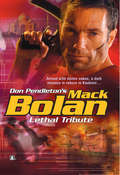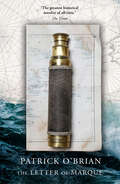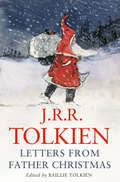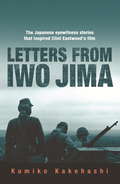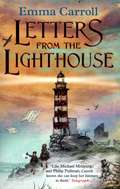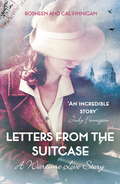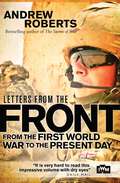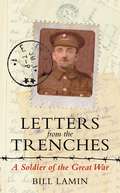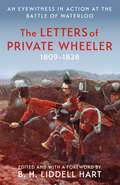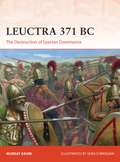- Table View
- List View
Lethal Risk
by Don PendletonSHADOW CHASE A high-ranking Chinese official has arranged to defect to the United States and reveal war crimes his country has perpetrated throughout Asia. But while en route to discreetly bring the official to American soil, Mack Bolan learns the man has been arrested, and the mission becomes much more urgent. And dangerous.
Lethal Tribute
by Don PendletonDANCE OF DESTRUCTION Wiped out a century ago in India, the ancient Cult of Kali has been reborn. Organized, well-funded and with clandestine contacts in high places, these death worshippers have an agenda of serious destruction, backed by three stolen nuclear warheads from Pakistan.
The Letter: The most heartwrenching love story and World War Two historical fiction for summer reading
by Kathryn HughesEvery so often a love story comes along to remind us that sometimes, in our darkest hour, hope shines a candle to light our way. 🕯️This Number One bestseller has captured thousands of hearts worldwide. Perfect for fans of The Notebook by Nicholas Sparks.'A wonderful, uplifting story' Lesley Pearse_______Tina Craig longs to escape her violent husband. She works all the hours God sends to save up enough money to leave him, also volunteering in a charity shop to avoid her unhappy home. Whilst going through the pockets of a second-hand suit, she comes across an old letter, the envelope firmly sealed and unfranked. Tina opens the letter and reads it - a decision that will alter the course of her life for ever...Billy Stirling knows he has been a fool, but hopes he can put things right. On 4th September 1939 he sits down to write the letter he hopes will change his future. It does - in more ways than he can ever imagine...THE LETTER tells the story of two women, born decades apart, whose paths are destined to cross, and how one woman's devastation leads to the other's salvation._______Join the hundreds of thousands of readers worldwide who have fallen in love with THE LETTER:'An amazing, heartwrenching, unforgettable story''This beautiful story will bring tears and joy''Loved this story !! It kept me totally gripped although I was sobbing in places as well''A tale of love and hope with lots of twists and turns. A great story!'
The Letter of Marque: Aubrey/maturin Series, Book 12 (Aubrey/Maturin Series #12)
by Patrick O’BrianPatrick O’Brian’s Aubrey-Maturin tales are widely acknowledged to be the greatest series of historical novels ever written. Now, for the first time, they are available in electronic book format, so a whole new generation of readers can be swept away on the adventure of a lifetime. This is the twelfth book in the series.
Letter To An Unknown Soldier: A New Kind Of War Memorial
by Kate Pullinger Neil BartlettOn Platform One of Paddington Station in London, there is a statue of an unknown soldier; he’s reading a letter. On the hundredth anniversary of the declaration of war everyone in the country was invited to take a moment and write that letter. A selection of those letters are published here, in a new kind of war memorial – one made only of words.
Letters from Father Christmas
by J. R. TolkienThis new ebook version of Tolkien's timeless classic presents readers with a plethora of full colour images of the original letters alongside the transcribed text, offering a truly engrossing reading experience.
Letters From Iwo Jima: The Japanese Eyewitness Stories That Inspired Clint Eastwood's Film
by Kumiko KakehashiLetters from Iwo Jima reveals the true story of the Battle of Iwo Jima, the subject of two films directed by Clint Eastwood. Flags of Our Fathers tells the story of the US Marines who raised the flag above the island: the iconic image of the war with Japan. His other film, Letters from Iwo Jima, tells the story from the Japanese point of view. At the heart of the story is the maverick general Tadamichi Kuriyabashi, devoted family man, brilliant leader and the first man on the island to know they were all going to die.As Clint Eastwood comments, 'General Kuribayashi was a unique guy. He liked America. He thought it was a mistake to go to war . . . America was too big an industrial complex.' Unlike most Japanese officers, he had travelled abroad, spent time in America and was under no illusions as to the ultimate end. He fought and died to delay the Americans for as long as he could. He knew that once the island fell, it would be used as an airbase by US bombers to strike at Tokyo. His unorthodox methods made this the fiercest battle the US Marines have ever faced, and he sustained resistance far longer than anyone believed possible.Kumiko Kakehashi's heart-rending account is based on the letters written home by the doomed soldiers on the island, mostly family men, conscripted late in the war. She reveals a very different Japanese army from the popular image. It is an incredibly moving portrayal of men determined to resist to the last breath, despite their profound opposition to the regime that led them into war.
Letters From Khartoum: Written During the Siege
by Frank PowerIt was in May, 1883, that Edmund Dwyer Gray, the chairman of the Freeman’s Journal, conceived the idea of making his paper a pioneer in providing its readers with foreign news. The Soudan, as it was then known, was in a state of wild unrest. The Mahdi’s followers had revolted, and British troops in and around Khartoum were having a bad time. The years 1884 and ‘85 were fraught with gravest apprehensions for their safety.No American or English journals had correspondents in any part of North Africa, and since a brief message had come through to London announcing the destruction of Col. William Hicks’ Army—annihilated on its way to attack the Mahdi’s headquarters—nothing had been learned of subsequent events. It was then that Mr. Gray seized the occasion, and made the Dublin Freeman’s Journal one of the most frequently-quoted publications of our time.The man he chose, Mr. Frank Power, known to his colleagues in Dublin’s Prince’s street as “Ghazi” Power, was the most dare-devil, resourceful and versatile member of his staff, equal to any emergency and avid for the ordeal that would try his mettle. His employer handed him a blank cheque, and told him to make all speed from Gravesend to Cairo, and, by hook or crook, to penetrate into Khartoum and dispatch all that he could gather about the state of affairs there and in the country around.The Government replies that followed were based on Freeman’s Journal despatches or telegrams to Whitehall, and all revealed the growing gravity of the situation. Before many weeks of 1885 had expired the tragic news came from Mr. Power that General Gordon and several of his staff had been butchered in January by the Mahdi’s mercenaries.Mr. Power’s letters brought the story of the siege down to July 31st, 1884, and the present volume consisting of Power’s letters to his family describing the siege of Khartoum was first published the following year.
Letters From The Lighthouse (PDF)
by Emma CarrollWe weren't supposed to be going to the pictures that night. We weren't even meant to be outside, not in a blackout, and definitely not when German bombs had been falling on London all month like pennies from a jar. February, 1941. After months of bombing raids in London, twelve-year-old Olive Bradshaw and her little brother Cliff are evacuated to the Devon coast. The only person with two spare beds is Mr Ephraim, the local lighthouse keeper. But he's not used to company and he certainly doesn't want any evacuees. Desperate to be helpful, Olive becomes his post-girl, carrying secret messages (as she likes to think of the letters) to the villagers. But Olive has a secret of her own. Her older sister Sukie went missing in an air raid, and she's desperate to discover what happened to her. And then she finds a strange coded note which seems to link Sukie to Devon, and to something dark and impossibly dangerous.
Letters From The Suitcase
by Cal Finnigan Rosheen FinniganTHE LETTERS FROM THE SUITCASE by Rosheen and Cal Finnigan reveals the detailed and poignant wartime romance between David and Mary Francis. For readers of Sheila Hancock's MISS CARTER'S WAR or Helen Simonson's MAJOR PETTIGREW'S LAST STAND 'I still have that recurring fear of something happening to me before I see you again, and before I can tell you myself just how much and how often I've realised during the last few months that I love you completely and to the exclusion of all others. Remember that, because if there wasn't you, my darling Mary, the world would seem very empty and meaningless.'Mary and David Francis were only twenty-one and nineteen when they met in 1938. They fell in love instantly, and against the wishes of David's parents, they lived together and married, in secret. These poignant letters reveal their intelligence and thoughtfulness, their passion, the everyday details of their lives working as a secretary at Bletchley Park and as a young officer in action on the other side of the world, and Mary's experience of bringing up a small baby alone in London. David was to die in India, five years after their first encounter, though his letters continued to reach Mary long after the event. At heart, this is the story of a young couple who were utterly devoted to one another. It is also the story of a father that Rosheen Finnigan never knew but came to love.
Letters from the Blitz: Telling America the Truth about the British Experience of War
by Richard MacAlpineWhen war was declared in September 1939, everyday life for British citizens changed almost overnight. At the time, Winifred Graville of Sheffield, a gardener, writer and speaker well known in her local area, wrote a series of letters to her American cousin in Penn Yan, New York, describing the hardships and typical daily struggles her city experienced during the Blitz. At a time when American public opinion was strictly isolationist, Winifred’s cousin convinced the editor of a local newspaper to publish excerpts from 150 letters in the hope of influencing public opinion in a small way. In Letters from the Blitz, Richard MacAlpine has gathered the published letters into a fascinating collection. At times poignant, often humorous, and always beautifully written and full of detail, Winifred’s letters clearly illustrate the ‘Keep Calm and Carry On’ attitude of the British people during that difficult time and provide an insight into wartime life.
Letters from the Front: From the First World War to the Present Day (General Military Ser.)
by Andrew Roberts The Imperial MuseumA legacy of an empire and a nation at war, Letters from the Front is a collection of correspondence sent by British and Commonwealth troops from the front line of war to their loved ones at home. Poignant expressions of love, hope and fear sit alongside amusing anecdotes, grumbles about rations and thoughtful reflections, eloquently revealing how, despite the passage of time, the experiences of the fighting man are shared in countless wars and battles across history. From the muddy trenches of the Somme through the frozen ground of the Falklands to the heat and dust of Afghanistan today, these letters are the ordinary soldier's testament to life on the front line.
Letters from the Front: From the First World War to the Present Day
by Andrew Roberts The Imperial The Imperial War MuseumA legacy of an empire and a nation at war, Letters from the Front is a collection of correspondence sent by British and Commonwealth troops from the front line of war to their loved ones at home. Poignant expressions of love, hope and fear sit alongside amusing anecdotes, grumbles about rations and thoughtful reflections, eloquently revealing how, despite the passage of time, the experiences of the fighting man are shared in countless wars and battles across history. From the muddy trenches of the Somme through the frozen ground of the Falklands to the heat and dust of Afghanistan today, these letters are the ordinary soldier's testament to life on the front line.
Letters From The Trenches: A Soldier of the Great War
by Bill LaminHarry Lamin was born in Derbyshire in 1877 and left school at thirteen to work in the lace industry, but by December 1916 he had been conscripted into the 9th Battalion, York and Lancaster Regiment and sent to war. Harry's letters home to his family describe the conflict with a poignant immediacy, even ninety years on, detailing everything from the action in battle to the often amusing incidents of life amongst his comrades. Throughout the letters, Harry's tone is unwaveringly stoical, uncomplaining and good humoured. Letters From The Trenches is a fitting tribute to the unsung heroes of the Great War who fought and endured and returned home, and the one in six who did not. The letters describe the war through the eyes of those who really lived it, bringing the horrors and triumphs to life for the twenty-first-century reader. Edited by Harry's grandson, Bill, Letters From The Trenches tells the moving story of a brave, selfless and honourable man who endured everything that the war could throw at him, and still came up smiling.
The Letters of Franklin K. Lane
by Louise Herrick Wall Anne Wintermute Franklin K. LaneA selection of letters written by Franklin K. Lane.
The Letters of Private Wheeler: An eyewitness in action at the Battle of Waterloo (MILITARY MEMOIRS)
by B.H. Liddell Hart'In a later age he would have become a successful war correspondent ... We have no more human account of the Peninsular War from a participant in all its battles. Vivid images - of people, landscapes, events - flows from his pen ... One of military history's great originals' John Keegan, DAILY TELEGRAPHThese letters, in the form of a frank and amusing diary, were written by a private in Wellington's army who fought throughout the Napoleonic Wars. Private Wheeler's record covers the Peninsular Campaign, keeping order during the coronation of Louis XVIII (whom he called 'an old bloated poltroon') and his later posting to Corfu.Most of all, Wheeler's account of the historic Battle of Waterloo - written before the muskets of battle had cooled - reveals him to be a master of lively anecdote and mischievous characterisation.
Letters To My Grandchildren: Thoughts On The Future
by Tony BennAs a diarist I have chronicled the time through which I have lived in meticulous detail: but all that is history. What matters now is the future for those who will live through it.The past is the past but there may be lessons to be learned which could help the next generation to avoid mistakes their parents and grandparents made.Certainly at my age I have learned an enormous amount from the study of history - not so much from the political leaders of the time but from those who struggled for justice and explained the world in a way that shows the continuity of history and has inspired me to do my work.Normality for any individual is what the world is like on the day they are born. The normality of the young is wholly different from the normality of their grandparents.It is the disentangling of the real questions from the day to day business of politics that may make sense for those who take up the task as they will do.Every generation has to fight the same battles as their ancestors had to fight, again and again, for there is no final victory and no final defeat. Two flames have burned from the beginning of time - the flame of anger against injustice and the flame of hope. If this book serves its purpose it will fan both flames.
Leuctra 371 BC: The Destruction of Spartan Dominance (Campaign)
by Murray DahmThe battle of Leuctra, fought in early July in 371 BC was one of the most important battles ever to be fought in the ancient world. Not only did it see the destruction of the Spartan dominance of Greece, it also introduced several tactical innovations which are still studied and emulated to this day. Sparta's hegemony of Greece (which had been in effect since the Persian wars of 480/79 and especially since the Peloponnesian War in 431-404 BC) was wiped away in a single day of destruction. Sparta would never recover from the losses in manpower which were suffered at Leuctra. Sparta's defeat created a power vacuum in Greece which several states attempted to fill (the Theban Hegemony and the resurgence of Athens) and gave rise to the dominance of Macedon in the 350s when Macedon would conquer Greece in 338 BC at the battle of Chaeronea. None of which would have been possible without the events at Leuctra. The Theban phalanx at Leuctra, with its great depth of 50 ranks introduced new tactical thinking in Greek warfare and this thinking eventually led to the Macedonian phalanx of Philip and Alexander which conquered Greece and the Persian Empire less than 40 years later. The Theban commander at Leuctra, Epaminondas, also introduced the idea of drawing up his forces in echelon and fighting with a refused flank – something Alexander emulated in all of his major battles and which has been attempted at countless battles since.The importance of the battle of Leuctra cannot be underestimated. This superbly illustrated title gives the reader a detailed understanding of this epic clash of forces, what led to it, its commanders, sources and the consequences it had for future civilizations.
Leuctra 371 BC: The Destruction of Spartan Dominance (Campaign #363)
by Murray DahmThe battle of Leuctra, fought in early July in 371 BC was one of the most important battles ever to be fought in the ancient world. Not only did it see the destruction of the Spartan dominance of Greece, it also introduced several tactical innovations which are still studied and emulated to this day. Sparta's hegemony of Greece (which had been in effect since the Persian wars of 480/79 and especially since the Peloponnesian War in 431-404 BC) was wiped away in a single day of destruction. Sparta would never recover from the losses in manpower which were suffered at Leuctra. Sparta's defeat created a power vacuum in Greece which several states attempted to fill (the Theban Hegemony and the resurgence of Athens) and gave rise to the dominance of Macedon in the 350s when Macedon would conquer Greece in 338 BC at the battle of Chaeronea. None of which would have been possible without the events at Leuctra. The Theban phalanx at Leuctra, with its great depth of 50 ranks introduced new tactical thinking in Greek warfare and this thinking eventually led to the Macedonian phalanx of Philip and Alexander which conquered Greece and the Persian Empire less than 40 years later. The Theban commander at Leuctra, Epaminondas, also introduced the idea of drawing up his forces in echelon and fighting with a refused flank – something Alexander emulated in all of his major battles and which has been attempted at countless battles since.The importance of the battle of Leuctra cannot be underestimated. This superbly illustrated title gives the reader a detailed understanding of this epic clash of forces, what led to it, its commanders, sources and the consequences it had for future civilizations.
Leuthen: Great Battles (Great Battles)
by T. G. OtteLeuthen (1757) is one of the best-known battles of the Seven Years' War, the most consequential conflict in continental Europe between the Thirty Years' War and the wars of Revolutionary and then Napoleonic France. It was a victory against the odds, over a vastly superior Austrian enemy who held the initiative in the war. Leuthen confirmed the reputation of Frederick II ('the Great') of Prussia as one of history's greatest military commanders. His victory rested on superior drill and firepower, intelligent use of the terrain, and his perfecting of the 'oblique battle order'. But faulty intelligence and flawed decision-making on the Austrian side were no less important, as T.G. Otte shows in this reappraisal of events. Leuthen was of profound significance for the war and for the future course of European history. Frederick's victory reversed the military dynamic of the current conflict. It kept Prussia in the war, preserved the existence of the Prussian state, and laid the foundations of its further rise with consequences beyond Frederick's own times. It also ensured Britain's final commitment to what was becoming a global conflict. The significance of Prussia's victory extended beyond the military sphere. The 'Leuthen myth', encapsulated in the evocative image of Frederick's exhausted grenadiers intoning the church hymn 'Now thank ye all our Lord', shaped political and historical disputes in nineteenth- and twentieth-century Germany. It also influenced the intellectual assumptions that underpinned Prusso-German war planning before the First World War. The 'Chorale of Leuthen' provided the accompanying chords of German cultural developments up to the collapse of the Third Reich in the burning ruins of Berlin. But even to the present day its echo can still be heard. As with other great battles, Leuthen is constantly reassessed and rewritten as an element of national culture and identity.
The Levant Trilogy: 'Fantastically tart and readable' Sarah Waters (Fortunes Of War Ser.)
by Olivia Manning'Fantastically tart and readable' Sarah Waters 'These books are clearly among the very best fiction about the Second World War. They are written with the English poise and understatement that Jane Austen raised to its highest art form' Chris Patten, The Sunday Times 'The finest fictional record of the war produced by a British writer' Anthony Burgess In the spring of 1941, a young English couple, Guy and Harriet Pringle, arrive in Egypt as Rommel's forces slowly but surely approach Cairo across the Sahara from the west. Will the city fall? In the streets the people contemplate welcoming a new set of occupiers, while European refugees and well-heeled Anglo-Egyptians prepare to pack their bags. And at night, everyone who is anyone flocks to the city's famed hotels and seedy cabarets, seeking one last dance before the tanks roll in. Manning describes the Pringles' ever complicated marriage and their motley group of friends and foes with a sharp eye. And the civilian world meets the military through the figure of Simon Boulderstone, a young army officer who will witness the tragedy and tension of war on the frontier at first hand.
Lewes and Evesham 1264–65: Simon de Montfort and the Barons' War (Campaign #285)
by Richard Brooks Mr Graham TurnerAt the crescendo of the Second Barons' War were the battles of Lewes and Evesham. It was an era of high drama and intrigue, as tensions between crown and aristocracy had boiled over and a civil war erupted that would shape the future of English government. In this detailed study, Richard Brooks unravels the remarkable events of the battles of Lewes and Evesham, revealing the unusually tactical nature of the fighting, in sharp contrast to most medieval conflicts which were habitually settled by burning and ravaging. At Lewes, Simon de Montfort, the powerful renegade leader of the Baronial faction, won a vital victory, smashing the Royalist forces and capturing Henry III and Prince Edward. Edward escaped, however, to lead the Royalist armies to a crushing victory just a year later at Evesham. Using full colour illustrations, bird's-eye views and detailed maps to generate an arresting visual perspective of the fighting, this book tells the full story of the battles of Lewes and Evesham, the only pitched battles to be fought by English armies in the mid-13th century.
Lewes and Evesham 1264–65: Simon de Montfort and the Barons' War (Campaign #285)
by Graham Turner Richard BrooksAt the crescendo of the Second Barons' War were the battles of Lewes and Evesham. It was an era of high drama and intrigue, as tensions between crown and aristocracy had boiled over and a civil war erupted that would shape the future of English government. In this detailed study, Richard Brooks unravels the remarkable events of the battles of Lewes and Evesham, revealing the unusually tactical nature of the fighting, in sharp contrast to most medieval conflicts which were habitually settled by burning and ravaging. At Lewes, Simon de Montfort, the powerful renegade leader of the Baronial faction, won a vital victory, smashing the Royalist forces and capturing Henry III and Prince Edward. Edward escaped, however, to lead the Royalist armies to a crushing victory just a year later at Evesham. Using full colour illustrations, bird's-eye views and detailed maps to generate an arresting visual perspective of the fighting, this book tells the full story of the battles of Lewes and Evesham, the only pitched battles to be fought by English armies in the mid-13th century.
The Lewis Gun (Weapon)
by Peter Dennis Neil Grant Alan GillilandDuring World War I, the British adopted the US-designed Lewis gun as an infantry weapon, realizing that its light weight and the fact that it could be fired both prone and on the move made it ideal for supporting advances and defending captured trenches. Later adopted by an array of countries from the Netherlands to Japan, the Lewis successfully served as the primary or secondary armament in armoured fighting vehicles and in both ground-based anti-aircraft and aircraft-mounted roles. Although it was superseded by the Bren in British service in 1937, the outbreak of World War II meant that thousands returned to active service, and it played a key role as far afield as Libya, with the Long-Range Desert Group, and the Philippines, with the US Marine Corps. Written by an authority on this iconic light machine gun, this is the fascinating story of the innovative and influential Lewis gun, from the trenches of World War I to the Libyan desert and Pacific islands of World War II and beyond.
The Lewis Gun (Weapon #34)
by Peter Dennis Neil Grant Alan GillilandDuring World War I, the British adopted the US-designed Lewis gun as an infantry weapon, realizing that its light weight and the fact that it could be fired both prone and on the move made it ideal for supporting advances and defending captured trenches. Later adopted by an array of countries from the Netherlands to Japan, the Lewis successfully served as the primary or secondary armament in armoured fighting vehicles and in both ground-based anti-aircraft and aircraft-mounted roles. Although it was superseded by the Bren in British service in 1937, the outbreak of World War II meant that thousands returned to active service, and it played a key role as far afield as Libya, with the Long-Range Desert Group, and the Philippines, with the US Marine Corps. Written by an authority on this iconic light machine gun, this is the fascinating story of the innovative and influential Lewis gun, from the trenches of World War I to the Libyan desert and Pacific islands of World War II and beyond.

